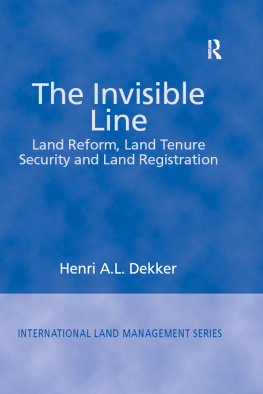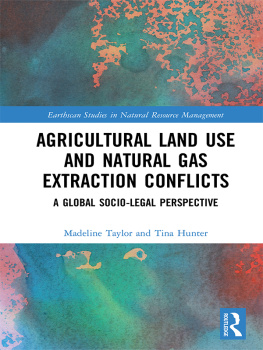First published 2002 by Ashgate Publishing
Reissued 2018 by Routledge
2 Park Square, Milton Park, Abingdon, Oxon OX14 4RN
711 Third Avenue, New York, NY 10017, USA
Routledge is an imprint of the Taylor & Francis Group, an informa business
Copyright Gloria L. Gallardo Fernndez 2002
All rights reserved. No part of this book may be reprinted or reproduced or utilised in any form or by any electronic, mechanical, or other means, now known or hereafter invented, including photocopying and recording, or in any information storage or retrieval system, without permission in writing from the publishers.
Notice:
Product or corporate names may be trademarks or registered trademarks, and are used only for identification and explanation without intent to infringe.
Publisher's Note
The publisher has gone to great lengths to ensure the quality of this reprint but points out that some imperfections in the original copies may be apparent.
Disclaimer
The publisher has made every effort to trace copyright holders and welcomes correspondence from those they have been unable to contact.
A Library of Congress record exists under LC control number: 2001099961
ISBN 13: 978-1-138-71831-9 (hbk)
ISBN 1.3: 978-1-315-19591-9 (ebk)
The idea for this dissertation was born in 1987. I was travelling from Santiago to the copper mine enclave Chuquicamata, in the Chilean desert, where my parents used to live, when the bus passed near my village Canela Baja, 300 km. north of Santiago, where I was born. After having been abroad almost half of my life, living in Poland, Sweden and Mexico, I was returning to Chile with the intention of putting down roots in my country. Reflecting then on my village and its communal land ownership - about which I discovered I knew practically nothing - the first, theoretical, question arose: how to conceive the 'persistence' or 'survival' of this form of ownership and agrarian production within a framework that, in my opinion, most would view as mainly capitalist, taking place in the country as a result of the changes that the Chilean agrarian structure has undergone since the 1960s.
These changes had not only modernised agriculture, but more importantly had destroyed the latifundium, for centuries the economic base of the national oligarchy. During the same period, paradoxically, the legal recognition of the agricultural communities, until then without any defined legal status, started to take form. Of these two social institutions - the latifundium and the agricultural communities - both rooted in the colonial period, the one that at the end of the 1900s was still 'surviving' was that of the agricultural communities. In this way, the 'endurance' of the agricultural communities became the 'disconfirming evidence' or empirical 'phenomenon' that appeared 'problematic' to me. Although I tried in my Master thesis to criticise the use of the theory of mode of productions, which in Latin-America drew its inspiration from Marx, yet long and largely by way of Althusser, I was still trying to analyse my village with the concepts of this theory, so fascinating but so sterile if not concerned with the study of concrete societies, societies that do not belong to the classical core of the European nations.
After I had formulated the first question, it followed that scientific curiosity about the origin of this type of community, would later provide me with my second question, I soon discovered that these communities had their origin in the colonial land grants and since these evolved into private property, I had an example of an 'inverted' transition between 'modes of productions'. The second question became how to conceive the transition from private property to the semi-communal ownership within this theory. This example came to reconfirm for me that while the theory about capitalism's development accounts for the general tendency, it is the study of specific cases that can help to determine in what circumstances and to which extent the requisites prescribed by the theory are fulfilled in a given social reality. Moreover, the study of 'deviant cases' at the micro level could help to refine the theoretical structure and avoid its oversimplification.
The investigation then took form with two sociologically relevant, empirical issues: historically, the development of semi-communal land ownership formed out of private property and presently, the reproduction of this form of semi-communal land ownership. In pursuing to treat these issues and trying to apprehend the questions they gave birth to, I included in the original thesis an overview of the different approaches about the small peasantry and its survival, passing through an overview of the theory of modes of production and what I considered was its inability to conceptualise particular cases which do not fit into the theory. I illustrated this with my case study applied both to the colonial and post-colonial period. Stevenson's approach on communal land ownership was thought to be an alternative and a complement to the Marxist approach.
As the study developed, however, the question of the form of the semi-communal land ownership became more and more dominant. When the case study was fully developed, the communal form and its historical development had become the central question. While my two original issues remained central, the two questions born from them became superfluous. Consequently, my intention to use them to highlight through particular cases the shortcomings of extrapolating the theory of modes production automatically to other historical contexts and material conditions also disappear.
Capitalism is however, the dominant mode of production and we cannot disregard that other forms of production are all related to it. Therefore, it is still valid in rhetorical terms to present communal land ownership as a paradox. As Marx might say, paradoxes are, however, apparent.
Many people have, in one way or another way, made this study possible. Among them I thank my advisers Docent Mats Franzn and PhD Mekuria Bulcha at the Department of Sociology as well as my second reader, Professor Bjrn Eriksson.
I would like to acknowledge in second place all those comuneros who shared their information about the agricultural communities with me. The list of comuneros and non comuneros is interminable. I constantly disturbed many people, starting with the priest, passing through the police to the Mayors in charge. I want, however, especially to thank among the comuneros, Pedro Carvajal, Joel Muoz and Emiliano Corts. Many other people contributed in different ways to this thesis during the years. Among them I thank for their tutorial supports during my time in Chile, the sociologists Sergio Gmez and Marcelo Charlin and the assistant Carmen Gloria, all from FLACSO, and the anthropologist Rigoberto Rivera from GIA in Santiago. I also thank here both Jos Joaqun Brunner and Norbert Lechner for opening the doors of FLACSO, giving me the chance to get in touch with Sergio and Marcelo. I am indebted to my friend, the journalist Patricia Moscoso, who rendered me many services from Chile during those years, as well as with my friends and cousins Editha Valencia and Miryam Ollarz. My gratitude to all those who helped me to carry out the survey during several days climbing hills up and down, including Camilo, the driver. I am also in debt to both the Archivo Nacional and Biblioteca Nacional and their staff in Santiago. I spent many days there.





